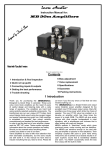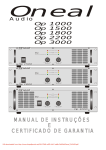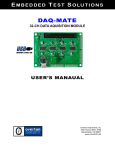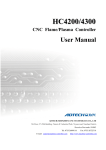Download Bob Carver BLACK BEAUTY VTA305M Owner`s manual
Transcript
BLACK BEAUTY 305 WATT VACUUM TUBE AMPLIFIER This manual provides general, ongoing use and safety information of the Black Beauty 305 (VTA305M) Mono Block Amplifier. General The new series of mono block amplifiers are the perfect blend of form and function and the ideal choice for serious music listeners. The Black Beauty is conservatively rated at 305 Watts rms into 8 ohms and was designed to drive the most demanding speakers. These amplifiers offer extreme performance that is difficult to believe, and each amplifier features a high impedance input, an automatic DC restorer circuit, a “set and forget” bias adjustment, and low idle current which greatly increases output tube life. They have ultra-wide bandwidth output transformers with interleaved windings capable of the most nuanced voice as well as huge peak output capacity. Selectable feedback control allows the user to change the sound of the amplifier from vintage classical to modern contemporary. From a listening perspective these amplifiers provide a warm, rich sound with a sumptuous and enveloping sound stage, a great front to back depth of field, and very tight, pin-point imaging within that larger acoustic. A special current feedback circuit allows the amplifier to “listen to the room” via feedback from the speakers acting as microphones (using the law of reciprocity). The room-speakeramplifier interaction provides a sense of believable ambience and acoustic space that is thoroughly realistic and quite enjoyable. Additionally, the transformer output impedance allows the signal to follow the impedance curve of the speaker system, allowing more voltage to be delivered to the loudspeaker at very low frequencies – providing an exceptional and satisfying low end response. Safe Operating Conditions Because of the high power available it is necessary to emphasize some prudent and safe operating conditions. 1. Be cautious when lifting the amplifier. It weighs 42 pounds. Make certain that what it is placed on can support the weight. 2. The amplifier should be situated so that its location or position does not interfere with its proper ventilation. The amplifier should never be placed near or over a radiator or heat 1|Page 3. 4. 5. 6. 7. 8. register. The amplifier should not be placed in a built-in installation such as a bookcase or cabinet that may impede the flow of air around the unit. Do not place this amplifier directly on carpeted floors. Do not operate the amplifier plugged into an ordinary extension cord. Heavy duty extension cords (14 ga. or heavier) have adequate wire size and will not overheat. If you plan on plugging a pair of these amplifier into a switched outlet on a preamplifier be sure that preamp outlets can handle 1500 watts total. Never connect or disconnect inputs or outputs while the amplifier is turned on. Loudspeakers can be damaged or destroyed by the high power available from the amplifier. The output tubes do get hot when the amplifier power switch is on. Do not touch the output tubes when the unit is on. If you need to change an output tube, wait 10 minutes after powering the unit down before you touch the tubes. Turn the amplifier off when not in use to save energy and extend the life of the tubes. Additional safety information is located at the back of this manual. CIRCUIT DESCRIPTION The input stage of these amplifiers consists of a 12AX7 current sourced, long-tailed balanced pair direct coupled to a second long-tailed balanced pair comprised of a 12AT7. The 12AT7 drives the grids of the output tubes through a pair of coupling capacitors that provide low frequency loop-gain stability. A 6AL5 DC restorer ensures that the bias voltage remains correct over the entire audio signal cycle. The output tubes are arranged in push pull parallel, three up, three down for a total of six in all. The KT120 screen grids are operated at approximately 390 volts provided by a separate power supply formed by one-half of a voltage doubler supplying the plates with 785 volts. The power supply consists of a large power transformer with energy storage that is far greater than necessary. AC filament voltage is biased to approximately 70 volts. Multiple decoupling filter sections are used with load regulation obtained through resistive constant current loading. Turn-on in-rush current limiting is provided by a thermistor, bias voltage adjustment by a rear panel bias control pot, feedback gain by a top-mounted front panel switch, volume by a volume control pot and bias current is displayed by a front mounted panel meter. A tube cathode fuse protects the output stage in the event of a catastrophic vacuum tube failure. Finally, a rear mounted power line fuse provides overall protection for the amplifier. VACUUM TUBES The output tubes do not need to be matched, as the sound of the amp does not at all depend on matched output tubes. That's because the DC restorer circuit eliminates the need to match tubes. The only caveat is that the output tubes should all be from the same manufacturer and same type. Looking at the amplifier from the front, from left to right, the first tube is a 12AX7, then a 12AT7, and finally the 6AL5. The six output tubes are; KT120s. 2|Page FEEDBACK SWITCH The small switch mounted on the top front of the chassis controls the amount of negative feedback. When the toggle handle is pushed LEFT (classic), the feedback is approximately 20 dB, a value used by most vintage amplifier designers and is my personal preference. When toggled RIGHT (contemporary), feedback is limited to about 11 dB. This represents the practice of many modern day designers. Please try it both and make your own determination based on your listening experience and your speakers. VOLUME CONTROL Under normal circumstances, this control should be left in the maximum (fully clockwise) position. If you have a noisy preamp, turning it halfway down and centering it at the 12:00 o'clock position will reduce the preamp noise by half, or 6 dB. It should always be turned all the way down when connecting or disconnecting any input or output in your system. The RCA audio input jack should be used to feed the signal into the amplifier from your signal source. REAR PANEL CONNECTIONS FUSES The rear panel IEC socket fuse is a 6 amp fast blow fuse, and should be replaced with the same type and rating if it ever needs replacing. The vacuum tube cathode fuse is a 1.5 amp fast blow and should 3|Page be replaced with the same type. Do not under any circumstances use "slow-blo" fuses. Both fuses are fast blow fuses. ADJUSTING THE OUTPUT TUBE BIAS The front panel incorporates a bias meter. Turn the volume control all the way down (full counter clockwise) while performing bias adjustments. Use a small screwdriver and adjust the bias control (located on the rear of the amplifier, “Tube Bias Adjustment”) for 100 mA after the unit has warmed-up for 20 minutes. The normal range setting is from 60 mA to 150 mA, and changes here will vary the damping factor of the amplifier slightly. More bias current increases the damping factor, whereas less bias current provides a softer more tube-like sound. The bias current design center should be set to 100 mA, and that should be your starting reference point if you want to experiment from there with different settings. Personally, I preferred the sound best on my speakers when I set the bias current to between 80 mA and 100 mA. It will vary from speaker to speaker, and more importantly with your taste. The meter reads the combined current for all six output tubes, and it is normal for this current to vary slightly with changes in power line voltage. SPEAKER CONNECTIONS From the rear view, the black binding post is common, and (moving to the right) the next red post is two ohms, then four ohms, and the far right post is for eight ohms. The power curve is quite flat, hence the two ohm tap may be used for one ohm speakers, and the eight ohm tap may be used for sixteen ohm speakers. To connect the speaker first check the impedance of the speaker which is usually identified on the speaker itself or in the owner's manual. Connect one lead from the common terminal of the speaker to the common terminal on the back of the amplifier. Connect the positive lead on the red terminal on the back of the speaker to one of the red output terminals on the back of the amplifier based on the impedance of the speaker. When multiple speakers are to be connected to the output, the combined load impedance must be calculated and the load connected to the appropriate impedance tap. If a load impedance is used that is lower than the output impedance tap, then reduced power and possible distortion will result. If a load impedance is used that is higher than the output impedance tap, then neither the signal nor the amplifier will be harmed but the voltage available is limited to that stated at that tap. 4|Page POWER SWITCH Up is on, down is off. There is no power-on indicator except for the glow of the tubes; you will have to remember whether you turned it on until you can see the tubes glow. It is safe to switch the amplifier on and off at will. LINE VOLTAGE This amplifier is configured for operation with 120V 60 Hz. COOLING Convection cooling - Cool air is drawn from under the chassis by the heat from the tubes acting as an air pump, and exhausting the warm air out the chassis through the top vents. Do not place the amplifier on a carpet or in a closed cabinet. You must allow the feet to do their job by keeping the bottom raised, allowing unimpeded airflow. MONITORING Once the bias has been set, it will normally not need to be adjusted for several years unless you want to experiment for different sound. Or if you install replacement output tubes, or the amplifier suddenly starts to sound funny. If you hear a POP and see a flash, yet the amp continues to play, you should first check the current by looking at the front panel meter, and then the 1.5A output tube fuse. Remember that if either of the fuses blow, the output current will drop to zero. If the TUBE fuse blows, replace it WITHOUT replacing any tubes. Turn the amp on and monitor the current. If it climbs to within the range you had set, and if the amp sounds good, all is well. Often an output tube has a spec of dust-like impurity, which comes into contact with an internal element, shorts the element and gets itself vaporized into gaseous oblivion. The getter, the mirror-like shiny plating on the inside of the tube does its job, absorbs the vaporized material and the tube is like new again. All it takes is a new fuse. If you install a new fuse and it blows again, you will need to determine which tube is the culprit. Proceed as follows: turn the amplifier off and allow hot tubes to cool, remove all 6 of the output tubes and turn the volume control all the way down (full counter clockwise). Turn the amp on and LEAVE IT ON. While monitoring the bias current by watching the meter, put a tube into socket number six (the far right front socket). Allow 60 seconds for the tube to warm up. If the bias current comes up to about one sixth the normal amount, the tube is good. Remove the tube - you can do it with your bare fingers, as one minute is not long enough for it to get too hot to hold - and install another tube, also in socket six. Replace one-by-one, until a fuse blows or one of the tubes does not show a bias current. Replacement tubes are available for free from the Bob Carver factory if one blows under the one year tube warranty period. If a tube blows beyond the warranty period we recommend you purchase a replacement from us as we purchase large amounts of tubes and provide a very competitive price for a tested, known good tube from our preferred tube supplier. 5|Page TUBE TESTER The front panel meter may be used to test the tubes. Remove all the large power output tubes; plug the amp into the AC wall socket with the main rear panel power switch OFF. Insert the tube you wish to test into socket #6 (the far right front socket). Turn the bias control fully clockwise and turn the main power switch ON. With a watch, time the warm-up period for exactly one minute and note the current reading. Turn the amplifier OFF, remove the tube and insert the next one. You can hold the tube with your bare fingers - it will not be too hot after only a minute, provided it was cool at the start. Keep track of each reading, and repeat until all tubes have been checked. If any one tube does not bias up or “runs away” with its current climbing substantially higher ~ 200% than the others, then it must be replaced. It is okay to turn the amp on and off at will. Return the bias control to its original position and put all the tubes back into their sockets. This completes the tube testing operation. MATCHING OUTPUT TUBES Matching output tubes is not necessary, thanks to the DC restorer. But it’s fun to do anyway. Test each tube as noted above, but write down the current on each tube one at a time. You will end up with six numbers. The goal is to select two groups of three whose sum (from any three tubes) is as close as you can get to a similar sum from the other group of three tubes. When you are finished determing the the two groups, add up the current in each group and check that they are as close as you can get them. This is a bit of trial and error; while you have them on the table in front of you and are adding the currents up, you may have to switch a tube or two from one group to the other to get the closest sums. Then install the first group in sockets #1, #3, #5, the odd sockets. Install the other group into sockets #2, #4, #6, the even sockets. The socket positions on the amp are, from left to right, looking from the front. 1,2,3,4. The last two positions 5, 6, are the front tubes on the right. The front left tube is #5, then #6 is to its right. SMALL TOGGLE SWITCH There is one toggle switch on the top front. It controls the feedback as mentioned earlier. Thrown left is classical, right is contemporary. NEW AMPLIFIER SMELL Like a brand new car, this amplifier possesses a "new amplifier smell". When powered up for the first time, the fresh paint and recent skin oils on the tubes will create a new hot amp smell. It will dissipate with use, usually requiring about six weeks of normal operation. 6|Page Black Beauty 305W Mono Block Amplifier Specifications Number of Line Inputs Input impedance Input Stage Pre-driver Stage Automatic DC Restoration Nominal Voltage Gain Output Stage Configuration Regulated Screen Supply Voltage Output tube plate voltage Output tube Idle Power Bias Adjustment Rated Power Noise Hum Frequency Response Full Power Bandwidth Feedback Control Switch Distortion Output Transformer Output Impedance Speaker outputs Built in Output Tube tester Construction Method Components Dimensions Weight Color Country of Origin: Warranty: 1 100 k ohms 12AX7 current sourced long tailed balanced pair 12AT7 current sourced long tailed balanced pair 6AL5 30 dB (into 8 ohms) 3 complimentary sets of KT120s in a push pull configuration (6 total) 390V 785V Less than 14W each Rear panel pot, front panel meter, set and forget 305 watts into 8 ohms, 330 watts into four ohms, 290 watts into two ohms Better than 110 dB A Weighted referenced into 305 watts -100dB 2 Hz to 85 kHz. (-3dB) 24 Hz to 28 kHz. Without filters 20dB for Classic Amplifier Sound 11 dB for Contemporary Amplifier Sound Less than 0.5% Interleaved windings, super wideband low leakage inductance design 1.3 ohms 2, 4, and 8 ohm terminals Yes Point-to-Point hand wired axial and radial leaded components with star grounds and no circuit board traces or de-plugable connectors. High reliability wire wound and metal film resistors Metal polyester capacitors in the audio signal paths 14” long by 12.5” wide by 7.2” tall 84 pounds (38 kg) for a stereo pair, 42 pounds (19 kg) each Gloss black with Silver Trim United States of America Chassis - 7 Years, Tubes – 1 Year 7|Page Safety Information IMPORTANT SAFETY INFORMATION Read Information — All the safety and operating information should be read before the amplifier is plugged in. Follow Information — All operating and use information should be followed. Retain Information — Retain the safety and operating information for future reference. Heed Warnings — All warnings on the amplifier & in the operating instructions should be heeded. Ventilation — The amplifier should be situated so that its location or position does not interfere with its proper ventilation. The amplifier should never be placed near or over a radiator or heat register. The amplifier should not be placed in a built-in installation such as a bookcase or cabinet that may impede the flow of air through the ventilation openings. Do not place this amplifier directly on carpeted floors. Non-Use Periods — Amplifiers that are left unattended should be turned off via the rear panel switch to extend the life of the tubes and conserve energy. Grounding or Polarization — Do not defeat the safety purpose of the polarized or grounding-type plug. A polarized plug has two blades with one blade wider than the other blade. A grounding type plug has two blades and a third grounding prong. The polarized wide blade and the third prong are provided for your safety. If the provided plug does not fit your outlet, consult an electrician for replacement of the obsolete outlet. Power Cord Protection — Protect the power cord from being walked on or pinched particularly at plugs, convenience receptacles and the point where they exit from the amplifier. Water— Do not use the amplifier near water. Cleaning — Unplug the amplifier from the AC outlet before cleaning. Use only a dry cloth to clean. Object and Liquid Entry — Never insert objects of any kind through the openings of these amplifiers, as they may touch dangerous voltage points or short-out parts that could result in a fire or electric shock. Care should be taken so that objects do not fall and liquids are not spilled into the amplifier through openings in the enclosure. Servicing — Do not attempt to service these amplifiers yourself, as opening or removing the bottom cover WILL expose you to dangerous high voltages. Refer all servicing to Bob Carver LLC. Damage Requiring Service — These Amplifiers should be serviced by Bob Carver LLC when: A power supply connection or a plug has been damaged or If liquid has been spilled into the amplifier or objects have fallen into the amplifier or The amplifier has been exposed to water or moisture or The amplifier does not appear to operate normally or exhibits a marked change in performance or The amplifier has been dropped or the enclosure damaged. 8|Page Replacement Parts — When replacement parts are required, be sure the service technician has used replacement parts specified by the manufacturer or that have the same characteristics as the original part. Unauthorized substitutions may result in fire, electric shock, or other hazards. Safety Check — Upon completion of any service or repairs to this audio product, ask the service technician to perform safety checks to determine that the audio product is in proper operating condition. Lightning Storms — Unplug this amplifier during lightning storms or when unused for long periods CAUTION: - Changes or modifications not expressly approved by BOB CARVER LLC will void the manufacturer’s warranty. 9|Page WARRANTIES: Bob Carver LLC warrants that all equipment manufactured by us to be free from defects in materials and workmanship for seven (7) years (vacuum tubes – one (1) year). This warranty shall not apply (a) to equipment not manufactured by Bob Carver LLC (b) to equipment which has been repaired or altered by someone other than Bob Carver LLC (c) to equipment which shall have been subjected to negligence, accident, misuse, abuse, or damage by circumstances beyond Bob Carver LLC’s control, or due to improper operation, maintenance or storage, or to other than normal use or service. The foregoing warranties do not cover reimbursement for labor, transportation, removal, installation, replacement cartons or other expenses which may be incurred by the dealer in connection with repair or replacement. If you have any questions concerning the operation or maintenance of this equipment, please contact: CUSTOMER SERVICE Bob Carver LLC. 157 Venture Court, Suite 12 Lexington, KY 40356 (859) 258 – 9794 [email protected] 10 | P a g e



















